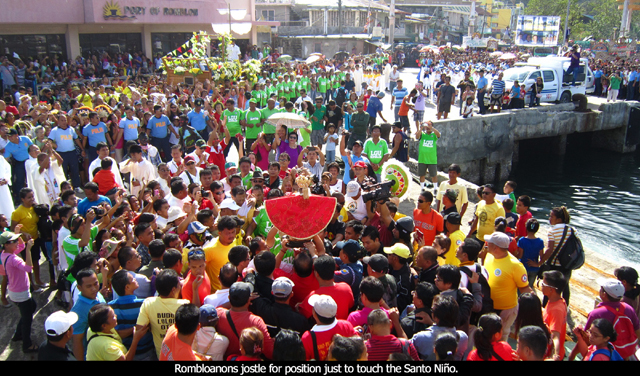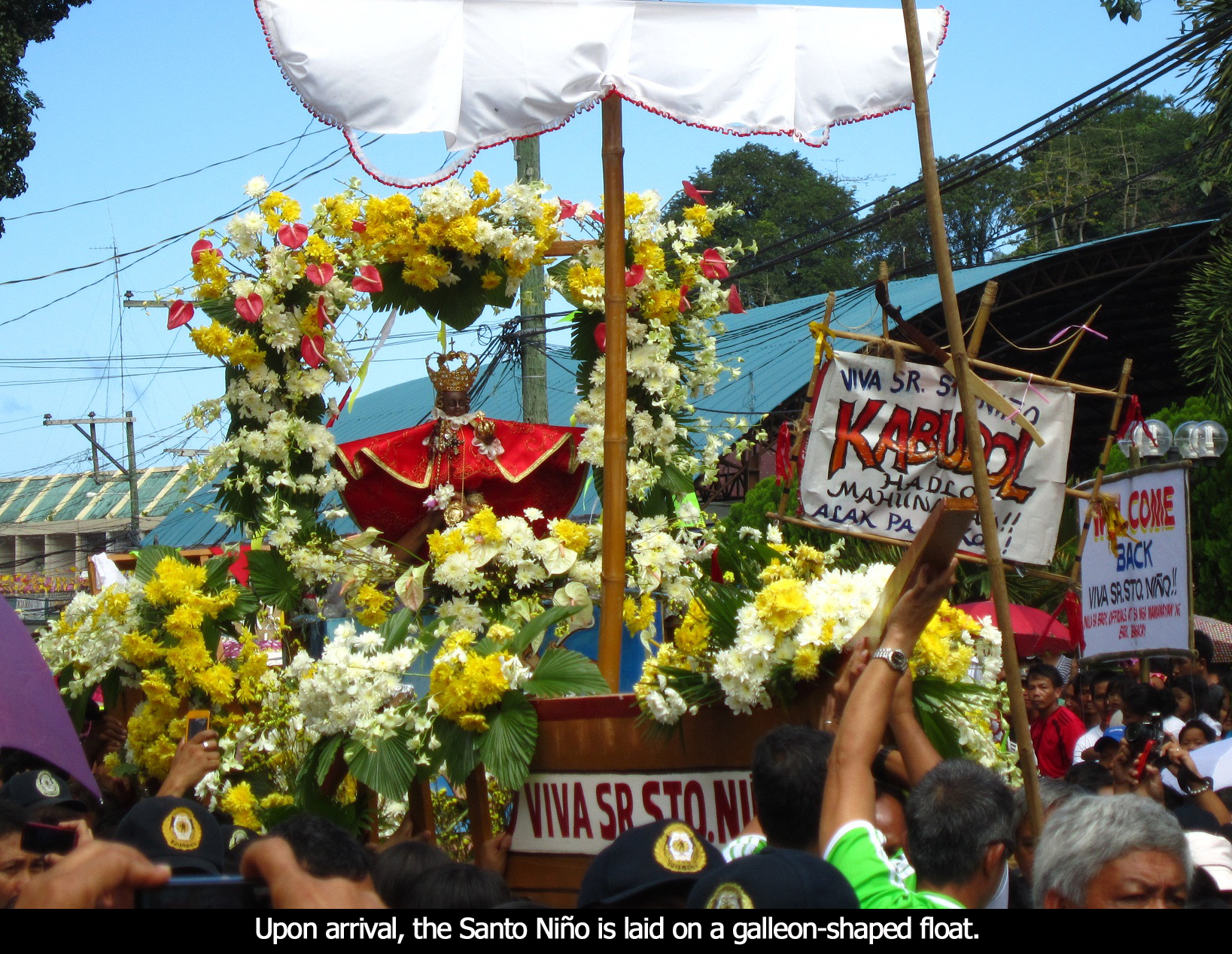ADVERTISEMENT
Filtered By: Publicaffairs
Public Affairs
KMJS Staff Blog: Longing for the Santo Niño de Romblon
By Allan Lazaro
When the 400-year-old Sto. Niño de Romblon was stolen from the altar of St. Joseph's Cathedral in Romblon in 1991, the people of Romblon thought they might never see it again. With its expensive clothes and crown made from gold, the item was sure to fetch an attractive price from antique collectors. Rombloanons were distraught by the loss, as they believed the image protected their beloved island.
When the image was miraculously recovered from an Aklan antique collector in January this year, the people of Romblon were amazed and delighted. After two decades, they welcomed the image back to their province with colorful celebrations.
In this first-person travelogue for GMA News Online, GMA segment producer Allan Lazaro writes about documenting the Sto. Niño de Romblon's long-overdue journey home. The story aired on the GMA magazine program "Kapuso Mo, Jessica Soho" last February 17, 2013.

Despite the early afternoon heat, a sizeable crowd had gathered at the port to gaze across the blue waters of Romblon Bay. Scattered around were energetic groups of Ati-atihan dancers, each one chanting and dancing to a unique drumbeat. But amidst all the merrymaking, all eyes followed the Maria Querubin, the ferry carrying the town’s beloved Santo Niño de Romblon, as it encircled the bay seven times for the Biniray or the traditional fluvial procession.
My assistant cameraman and I were among the throngs of people waiting at the port. We had already taken enough footage of the Biniray and we were just waiting for it to finish. My cameraman, on the other hand, was stuck aboard the ferry together with the Santo Niño. It had been more than two hours since the ferry set off and I’ve lost count how many times the Maria Querubin had encircled Romblon Bay. I wondered aloud if the ferry had already made its seventh and final tour, but the siopao vendor beside me shook her head. Three more rounds, she said.
Before its recent return to the little port town of Romblon just this January, the Santo Niño de Romblon had been missing for more than two decades. Most people believed the Santo Niño was stolen. Others claimed the Holy Child simply walked out of the church just like in the old tales.
Whatever the truth is behind its mysterious disappearance in the early hours of the December 1, 1991, the Santo Niño’s penchant for miracles had certainly caught the attention of many, including those with ill intentions.
And perhaps it’s partly because of its miraculous reputation that the Santo Niño de Romblon is still well loved even after all these years. Every Rombloanon we encountered would recount the Santo Niño’s many wondrous feats.
There’s the tale of the Santo Niño vanishing from its pedestal and then mysteriously reappearing days later with amorseko seeds stuck on its clothes. Or how a Spanish friar supposedly cut the Santo Niño’s feet off because it kept “walking off” its pedestal.
Of course, many Rombloanons also claim to having been healed of their illnesses by the Santo Niño. And with the Santo Niño’s return, many more are hoping for their own medical miracles.
The Santo Niño even supposedly protected the island of Romblon during World War II. The story goes that bomber planes couldn’t locate the island from above because the Santo Niño conjured thick clouds to shield Romblon from the eyes of the Japanese pilots. That’s why many Rombloanons believe that various disasters and catastrophes have struck them since the Santo Niño went missing in 1991.
Earlier this month, my crew and I accompanied the Santo Niño on a chartered flight aboard a 32-seater plane from Manila to Tablas Island. I thought the Santo Niño wouldn’t even get past Tablas Airport where a flock of devotees pushed and jostled for position just so they could touch the Santo Niño.
But as soon as its handlers managed to safely load it inside a pick-up truck, we drove along the island's zigzag coastal roads toward San Agustin Pier. We had to stop several times at the barangays, so the people could take a glimpse of our special passenger.

At the pier, another huge crowd was waiting for us. Fortunately, the Santo Niño was able to get on board the ferry without a hitch. Aboard the ferry, the passengers lined up to kiss or touch it. Meanwhile, dozens of boats suddenly emerged on both sides of the ferry, fishermen who wanted to escort the Holy Child back to its hometown. It was a truly majestic sight.
And as the town of Romblon came into view, I immediately spied that an even bigger crowd had gathered at the port to welcome the Santo Niño. It seemed like everyone in town assembled there.
Before disembarking from the ferry, a layer of "hawi" boys had encircled the Santo Niño, as if to protect Romblon’s healer and protector from its own people’s love and devotion. And true enough, everyone at the port pushed and pushed some more just so they could glimpse and touch the fabled Holy Child. It could have resulted in a tragic stampede but somehow it didn’t.

As the Santo Niño made its way to its galleon-shaped float, all around us people bellowed "Viva Señor Santo Niño!" Others quietly wiped the tears away from their eyes, as if the Holy Child was nothing but a miraculous apparition that might suddenly vanish, just like in the incredible stories the old Rombloanons told their children. Just like how it disappeared 21 years before.
But this Santo Niño wasn’t a mere illusion. It had come back triumphant and had taken its rightful place at its old pedestal. Miraculous or not, the joy the Santo Niño’s return brought to the people of Romblon was nothing but real.
That's why, if the Rombloanons could wait for the Holy Child’s return for more than two decades, then they could and would endure another couple of hours under the sun waiting for the Santo Niño to complete its voyage around the bay during the Biniray.
It’s no wonder, then, that the Rombloanons were all eyes on the Maria Querubin during the Biniray until the ferry came back to port. They probably didn’t want to lose sight of the Santo Niño ever again.
-ME/PF, GMA News
When the image was miraculously recovered from an Aklan antique collector in January this year, the people of Romblon were amazed and delighted. After two decades, they welcomed the image back to their province with colorful celebrations.
In this first-person travelogue for GMA News Online, GMA segment producer Allan Lazaro writes about documenting the Sto. Niño de Romblon's long-overdue journey home. The story aired on the GMA magazine program "Kapuso Mo, Jessica Soho" last February 17, 2013.

Despite the early afternoon heat, a sizeable crowd had gathered at the port to gaze across the blue waters of Romblon Bay. Scattered around were energetic groups of Ati-atihan dancers, each one chanting and dancing to a unique drumbeat. But amidst all the merrymaking, all eyes followed the Maria Querubin, the ferry carrying the town’s beloved Santo Niño de Romblon, as it encircled the bay seven times for the Biniray or the traditional fluvial procession.
My assistant cameraman and I were among the throngs of people waiting at the port. We had already taken enough footage of the Biniray and we were just waiting for it to finish. My cameraman, on the other hand, was stuck aboard the ferry together with the Santo Niño. It had been more than two hours since the ferry set off and I’ve lost count how many times the Maria Querubin had encircled Romblon Bay. I wondered aloud if the ferry had already made its seventh and final tour, but the siopao vendor beside me shook her head. Three more rounds, she said.
Before its recent return to the little port town of Romblon just this January, the Santo Niño de Romblon had been missing for more than two decades. Most people believed the Santo Niño was stolen. Others claimed the Holy Child simply walked out of the church just like in the old tales.
Whatever the truth is behind its mysterious disappearance in the early hours of the December 1, 1991, the Santo Niño’s penchant for miracles had certainly caught the attention of many, including those with ill intentions.
And perhaps it’s partly because of its miraculous reputation that the Santo Niño de Romblon is still well loved even after all these years. Every Rombloanon we encountered would recount the Santo Niño’s many wondrous feats.
There’s the tale of the Santo Niño vanishing from its pedestal and then mysteriously reappearing days later with amorseko seeds stuck on its clothes. Or how a Spanish friar supposedly cut the Santo Niño’s feet off because it kept “walking off” its pedestal.
Of course, many Rombloanons also claim to having been healed of their illnesses by the Santo Niño. And with the Santo Niño’s return, many more are hoping for their own medical miracles.
The Santo Niño even supposedly protected the island of Romblon during World War II. The story goes that bomber planes couldn’t locate the island from above because the Santo Niño conjured thick clouds to shield Romblon from the eyes of the Japanese pilots. That’s why many Rombloanons believe that various disasters and catastrophes have struck them since the Santo Niño went missing in 1991.
Earlier this month, my crew and I accompanied the Santo Niño on a chartered flight aboard a 32-seater plane from Manila to Tablas Island. I thought the Santo Niño wouldn’t even get past Tablas Airport where a flock of devotees pushed and jostled for position just so they could touch the Santo Niño.
But as soon as its handlers managed to safely load it inside a pick-up truck, we drove along the island's zigzag coastal roads toward San Agustin Pier. We had to stop several times at the barangays, so the people could take a glimpse of our special passenger.

At the pier, another huge crowd was waiting for us. Fortunately, the Santo Niño was able to get on board the ferry without a hitch. Aboard the ferry, the passengers lined up to kiss or touch it. Meanwhile, dozens of boats suddenly emerged on both sides of the ferry, fishermen who wanted to escort the Holy Child back to its hometown. It was a truly majestic sight.
And as the town of Romblon came into view, I immediately spied that an even bigger crowd had gathered at the port to welcome the Santo Niño. It seemed like everyone in town assembled there.
Before disembarking from the ferry, a layer of "hawi" boys had encircled the Santo Niño, as if to protect Romblon’s healer and protector from its own people’s love and devotion. And true enough, everyone at the port pushed and pushed some more just so they could glimpse and touch the fabled Holy Child. It could have resulted in a tragic stampede but somehow it didn’t.

As the Santo Niño made its way to its galleon-shaped float, all around us people bellowed "Viva Señor Santo Niño!" Others quietly wiped the tears away from their eyes, as if the Holy Child was nothing but a miraculous apparition that might suddenly vanish, just like in the incredible stories the old Rombloanons told their children. Just like how it disappeared 21 years before.
But this Santo Niño wasn’t a mere illusion. It had come back triumphant and had taken its rightful place at its old pedestal. Miraculous or not, the joy the Santo Niño’s return brought to the people of Romblon was nothing but real.
That's why, if the Rombloanons could wait for the Holy Child’s return for more than two decades, then they could and would endure another couple of hours under the sun waiting for the Santo Niño to complete its voyage around the bay during the Biniray.
It’s no wonder, then, that the Rombloanons were all eyes on the Maria Querubin during the Biniray until the ferry came back to port. They probably didn’t want to lose sight of the Santo Niño ever again.
-ME/PF, GMA News
More Videos
Most Popular




